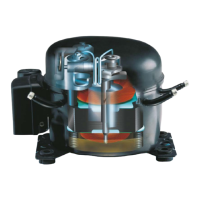54
30.
EVACUATION
After brazing, evacuation of the refrigeration system begins. When a vacuum below 1 mbar is achieved, the
system is pressure equalized before the final evacuation and charging of refrigerant. If a pressure test has
been performed directly before evacuation, the evacuation process is to be started smoothly, with low pump-
ing volume, to avoid oil loss from the compressor. Many opinions exist on how evacuation can be carried out
in the best way. Depending on the volume conditions of the suction and the discharge side in the refrigera-
tion system, it might be necessary to choose one of the following procedures for evacuation.
One-sided evacuation with continuous evacuation until a sufficiently low pressure in the condenser has been
obtained. One or more short evacuation cycles with pressure equalization in between is necessary.
Two-sided evacuation with continuous evacuation until a sufficiently low pressure has been acvhieved.
These procedures naturally require a good uniform quality (dryness) of the components used.
The first figure shows a typical
course of a one-sided evacuation
from the process tube of the com-
pressor. It also shows a pressure
difference measured in the con-
denser. This can be remedied by
increasing the numbers of pres-
sure equalizations. The dotted
line shows a procedure where two
sides are evacuated simultane-
ously.
If time is limited, the final vacuum
to be obtained is only dependent
on the capacity of the vacuum
pump and the content of non con-
densable elements or refrigerant
residues in the oil charge.
The advantage of a two-sided
evacuation is that it is possible to obtain a considerably lower pressure in the system within a reasonable
process time. This implies that it will be possible to build a leak check into the process in order to sort out
leaks before charging the refrigerant.
The second figure is an example
of a pre-evacuation process with
built-in leak test. The level of
vacuum obtained depends on the
process chosen. Two-sided evacu-
ation is recommended.
An explosion safe vacuum pump must be used for systems with the flammable refrigerants R600a and R290.
The same vacuum pump can be used for all refrigerants if it is charged with Ester oil.
30.1
Vacuum pumps

